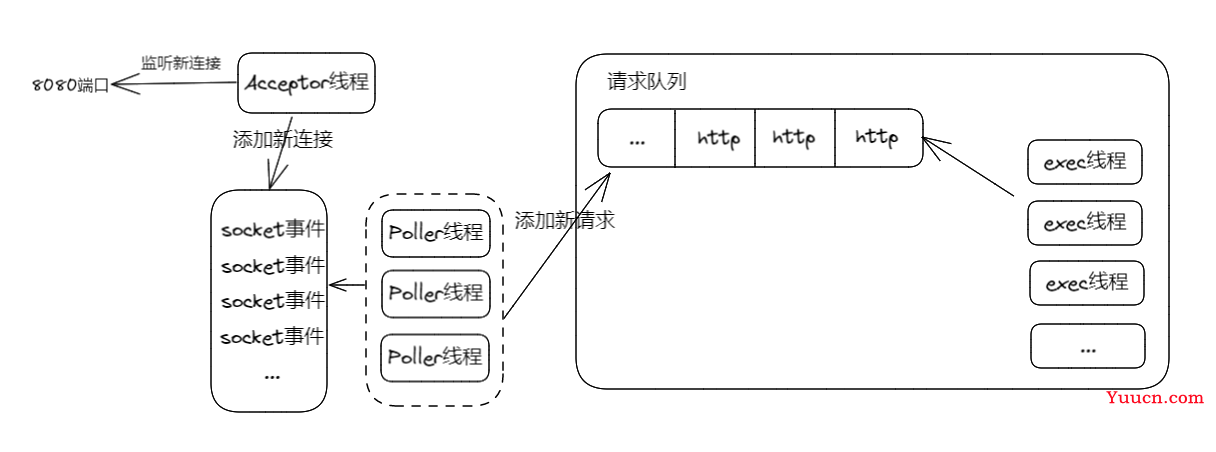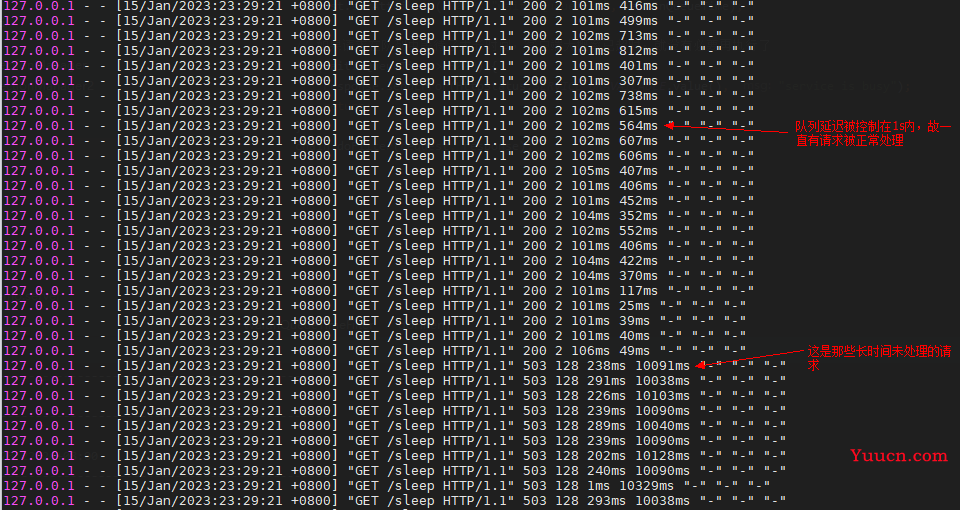原创:扣钉日记(微信公众号ID:codelogs),欢迎分享,转载请保留出处。
简介
最近我观察到一个现象,当服务的请求量突发的增长一下时,服务的有效QPS会下降很多,有时甚至会降到0,这种现象网上也偶有提到,但少有解释得清楚的,所以这里来分享一下问题成因及解决方案。
队列延迟
目前的Web服务器,如Tomcat,请求处理过程大概都类似如下:

这是Tomcat请求处理的过程,如下:
- Acceptor线程:线程名类似http-nio-8080-Acceptor-0,此线程用于接收新的TCP连接,并将TCP连接注册到NIO事件中。
- Poller线程:线程名类似http-nio-8080-ClientPoller-0,此线程一般有CPU核数个,用于轮询已连接的Socket,接收新到来的Socket事件(如调用端发请求数据了),并将活跃Socket放入exec线程池的请求队列中。
- exec线程:线程名类似http-nio-8080-exec-0,此线程从请求队列中取出活跃Socket,并读出请求数据,最后执行请求的API逻辑。
这里不用太关心Acceptor与Poller线程,这是nio编程时常见的线程模型,我们将重点放在exec线程池上,虽然Tomcat做了一些优化,但它还是从Java原生线程池扩展出来的,即有一个任务队列与一组线程。
当请求量突发增长时,会发生如下的情况:
- 当请求量不大时,任务队列基本是空的,每个请求都能得到及时的处理。
- 但当请求量突发时,任务队列中就会有很多请求,这时排在队列后面的请求,就会被处理得越晚,因而请求的整体耗时就会变长,甚至非常长。
可是,exec线程们还是在一刻不停歇的处理着请求的呀,按理说服务QPS是不会减少的呀!
简单想想的确如此,但调用端一般是有超时时间设置的,不会无限等待下去,当客户端等待超时的时候,这个请求实际上Tomcat就不用再处理了,因为就算处理了,客户端也不会再去读响应数据的。

因此,当队列比较长时,队列后面的请求,基本上都是不用再处理的,但exec线程池不知道啊,它还是会一如既往地处理这些请求。
当exec线程执行这些已超时的请求时,若又有新请求进来,它们也会排在队尾,这导致这些新请求也会超时,所以在流量突发的这段时间内,请求的有效QPS会下降很多,甚至会降到0。
这种超时也叫做队列延迟,但队列在软件系统中应用得太广泛了,比如操作系统调度器维护了线程队列,TCP中有backlog连接队列,锁中维护了等待队列等等。
因此,很多系统也会存在这种现象,平时响应时间挺稳定的,但偶尔耗时很高,这种情况有很多都是队列延迟导致的。
优化队列延迟
知道了问题产生的原因,要优化它就比较简单了,我们只需要让队列中那些长时间未处理的请求暂时让路,让线程去执行那些等待时间不长的请求即可,毕竟这些长时间未处理的请求,让它们再等等也无防,因为客户端可能已经超时了而不需要请求结果了,虽然这破坏了队列的公平性,但这是我们需要的。
对于Tomcat,在springboot中,我们可以如下修改:
使用WebServerFactoryCustomizer自定义Tomcat的线程池,如下:
@Component
public class TomcatExecutorCustomizer implements WebServerFactoryCustomizer<TomcatServletWebServerFactory> {
@Resource
ServerProperties serverProperties;
@Override
public void customize(TomcatServletWebServerFactory factory) {
TomcatConnectorCustomizer tomcatConnectorCustomizer = connector -> {
ServerProperties.Tomcat.Threads threads = serverProperties.getTomcat().getThreads();
TaskQueue taskqueue = new SlowDelayTaskQueue(1000);
ThreadPoolExecutor executor = new org.apache.tomcat.util.threads.ThreadPoolExecutor(
threads.getMinSpare(), threads.getMax(), 60L, TimeUnit.SECONDS,
taskqueue, new CustomizableThreadFactory("http-nio-8080-exec-"));
taskqueue.setParent(executor);
ProtocolHandler handler = connector.getProtocolHandler();
if (handler instanceof AbstractProtocol) {
AbstractProtocol<?> protocol = (AbstractProtocol<?>) handler;
protocol.setExecutor(executor);
}
};
factory.addConnectorCustomizers(tomcatConnectorCustomizer);
}
}
注意,这里还是使用的Tomcat实现的线程池,只是将任务队列TaskQueue扩展为了SlowDelayTaskQueue,它的作用是将长时间未处理的任务移到另一个慢队列中,待当前队列中无任务时,再把慢队列中的任务移回来。
为了能记录任务入队列的时间,先封装了一个记录时间的任务类RecordTimeTask,如下:
@Getter
public class RecordTimeTask implements Runnable {
private Runnable run;
private long createTime;
private long putQueueTime;
public RecordTimeTask(Runnable run){
this.run = run;
this.createTime = System.currentTimeMillis();
this.putQueueTime = this.createTime;
}
@Override
public void run() {
run.run();
}
public void resetPutQueueTime() {
this.putQueueTime = System.currentTimeMillis();
}
public long getPutQueueTime() {
return this.putQueueTime;
}
}
然后队列的扩展实现如下:
public class SlowDelayTaskQueue extends TaskQueue {
private long timeout;
private BlockingQueue<RecordTimeTask> slowQueue;
public SlowDelayTaskQueue(long timeout) {
this.timeout = timeout;
this.slowQueue = new LinkedBlockingQueue<>();
}
@Override
public boolean offer(Runnable o) {
// 将任务包装一下,目的是为了记录任务放入队列的时间
if (o instanceof RecordTimeTask) {
return super.offer(o);
} else {
return super.offer(new RecordTimeTask(o));
}
}
public void pullbackIfEmpty() {
// 如果队列空了,从慢队列中取回来一个
if (this.isEmpty()) {
RecordTimeTask r = slowQueue.poll();
if (r == null) {
return;
}
r.resetPutQueueTime();
this.add(r);
}
}
@Override
public Runnable poll(long timeout, TimeUnit unit) throws InterruptedException {
pullbackIfEmpty();
while (true) {
RecordTimeTask task = (RecordTimeTask) super.poll(timeout, unit);
if (task == null) {
return null;
}
// 请求在队列中长时间等待,移入慢队列中
if (System.currentTimeMillis() - task.getPutQueueTime() > this.timeout) {
this.slowQueue.offer(task);
continue;
}
return task;
}
}
@Override
public Runnable take() throws InterruptedException {
pullbackIfEmpty();
while (true) {
RecordTimeTask task = (RecordTimeTask) super.take();
// 请求在队列中长时间等待,移入慢队列中
if (System.currentTimeMillis() - task.getPutQueueTime() > this.timeout) {
this.slowQueue.offer(task);
continue;
}
return task;
}
}
}
逻辑其实挺简单的,如下:
- 当任务入队列时,包装一下任务,记录一下入队列的时间。
- 然后线程从队列中取出任务时,若发现任务等待时间过长,就将其移入慢队列。
- 而pullbackIfEmpty的逻辑,就是当队列为空时,再将慢队列中的任务移回来执行。
为了将请求的队列延迟记录在access.log中,我又修改了一下Task,并加了一个Filter,如下:
- 使用ThreadLocal将队列延迟先存起来
@Getter
public class RecordTimeTask implements Runnable {
private static final ThreadLocal<Long> WAIT_IN_QUEUE_TIME = new ThreadLocal<>();
private Runnable run;
private long createTime;
private long putQueueTime;
public RecordTimeTask(Runnable run){
this.run = run;
this.createTime = System.currentTimeMillis();
this.putQueueTime = this.createTime;
}
@Override
public void run() {
try {
WAIT_IN_QUEUE_TIME.set(System.currentTimeMillis() - this.createTime);
run.run();
} finally {
WAIT_IN_QUEUE_TIME.remove();
}
}
public void resetPutQueueTime() {
this.putQueueTime = System.currentTimeMillis();
}
public long getPutQueueTime() {
return this.putQueueTime;
}
public static long getWaitInQueueTime(){
return ObjectUtils.defaultIfNull(WAIT_IN_QUEUE_TIME.get(), 0L);
}
}
- 再在Filter中将队列延迟取出来,放入Request对象中
@WebFilter
@Component
public class WaitInQueueTimeFilter extends HttpFilter {
@Override
public void doFilter(HttpServletRequest request, HttpServletResponse response, FilterChain chain) throws
IOException,
ServletException {
long waitInQueueTime = RecordTimeTask.getWaitInQueueTime();
// 将等待时间设置到request的attribute中,给access.log使用
request.setAttribute("waitInQueueTime", waitInQueueTime);
// 如果请求在队列中等待了太长时间,客户端大概率已超时,就没有必要再执行了
if (waitInQueueTime > 5000) {
response.sendError(503, "service is busy");
return;
}
chain.doFilter(request, response);
}
}
- 然后在access.log中配置队列延迟
server:
tomcat:
accesslog:
enabled: true
directory: /home/work/logs/applogs/java-demo
file-date-format: .yyyy-MM-dd
pattern: '%h %l %u %t "%r" %s %b %Dms %{waitInQueueTime}rms "%{Referer}i" "%{User-Agent}i" "%{X-Forwarded-For}i"'
注意,在access.log中配置%{xxx}r表示取请求xxx属性的值,所以,%{waitInQueueTime}r就是队列延迟,后面的ms是毫秒单位。
优化效果
我使用接口压测工具wrk压了一个测试接口,此接口执行时间100ms,使用1000个并发去压,1s的超时时间,如下:
wrk -d 10d -T1s --latency http://localhost:8080/sleep -c 1000
然后,用arthas看一下线程池的队列长度,如下:
[arthas@619]$ vmtool --action getInstances \
--classLoaderClass org.springframework.boot.loader.LaunchedURLClassLoader \
--className org.apache.tomcat.util.threads.ThreadPoolExecutor \
--express 'instances.{ #{"ActiveCount":getActiveCount(),"CorePoolSize":getCorePoolSize(),"MaximumPoolSize":getMaximumPoolSize(),"QueueSize":getQueue().size()} }' \
-x 2

可以看到,队列长度远小于1000,这说明队列中积压得不多。
再看看access.log,如下:

可以发现,虽然队列延迟任然存在,但被控制在了1s以内,这样这些请求就不会超时了,Tomcat的有效QPS保住了。
而最后面那些队列延迟极长的请求,则是被不公平对待的请求,但只能这么做,因为在请求量超出Tomcat处理能力时,只能牺牲掉它们,以保全大局。